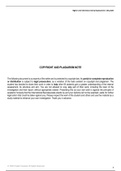Higher Level Chemistry Internal Assessment | May 2020
COPYRIGHT AND PLAGIARISM NOTE
The following document is a property of the seller and is protected by copyright law. Its partial or complete reproduction
or distribution is subject to legal prosecution, as a violation of the laws existent on copyright and plagiarism. The
student has decided to share their work in order to help other IB students gain a greater understanding of the internal
assessment, its structure and aim. You are not allowed to copy any part of their work, including the topic of the
investigation and their report, without appropriate citation. Presenting this as your own work is against the principle of
academic honesty that the International Baccalaureate stands by and your diploma will not be awarded, aside for further
legal action that could be taken against you. Please respect the work of the student and others and use the material as a
study material to enhance your own investigation. Thank you in advance.
© 2020 Orsalia Toutouza All Rights Reserved
1
, Higher Level Chemistry Internal Assessment | May 2020
An Investigation of the pH-Dependency of the Hydrolysis of Commercial Acetylsalicylic Acid
Related to Iron Chelation as a Protective Mechanism Against Carcinogenesis
1. RATIONALE
Being interested in following the medical profession, I was sincerely motivated towards exploring iron chelation
of salicylic acid through a chemical prism. As my father is a surgeon with a specialization in colorectal and pancreas
cancer, I become aware that aspirin is administered to most patients suffering from these types of cancer, as it is
considered effective in cancer treatment and management of such types. Based on the chemical background of aspirin
hydrolysis and iron chelation, I thought that aspirin intake in these particular types of cancer could have been due to
aspirin hydrolysis taking place much quicker in the acid organs of the digestive system, leading to more salicylic acid per
time unit to lower iron levels. While my thought was a simplistic synthesis of the information that came up during my
research, present studies on aspirin hydrolysis have concentrated on the pH-profile, without reference to its biological
significance in the context of cancer. The latter was only investigated in medical and biological researches, based on in
vivo studies using Aspirin™ tablets, which could not be replicated in an Internal Assessment. Therefore, being a student,
it would be more appropriate to carry out a chemical investigation of the pH-profile of aspirin hydrolysis for the acid pH
values of the digestive route and determine the effect of pH on the rate of Aspirin™ hydrolysis, which is indicative of
the salicylic acid produced and thus available for iron chelation.
2. RESEARCH QUESTION
How does the rate of hydrolysis of one 0.50g tablet of commercial acetylsalicylic acid (Aspirin™) in mol dm-3 s-1 and the
hydrolysis rate constant vary within the pH ranges (pH 1-2, pH 4-5 and pH 6-7) of organs of the gastrointestinal track
(stomach, jejunum, intestine), measured with a pH meter, and how does these relate to the administration of aspirin
as preventative medication for cancer, with regards to its iron-chelation mechanism?
3. BACKGROUND KNOWLEDGE
Aspirin™ is most certainly among the most widely used medication, administered as an antipyretic, antithrombotic
and analgesic to relieve mild pain both on a short-term and long-term basis. While several links have been uncovered
between acetylsalicylic acid, its chemical name, and several medical conditions, from asthma to neuralgia, the discovery
of iron chelation of salicylic acid, produced by the hydrolysis of acetylsalicylic acid, as a potential preventive and
degrading mechanism against carcinogenesis has been a breakthrough in cancer research. In fact, “long-term use of
low-dose aspirin at 75 mg has been associated with a remarkable decrease in cancer incidence and cancer death”
(Rothwell et al., 2011). Aspirin consumption for more than 7.5 years has been found to decrease cancer death by 31%
and 59% in gastrointestinal cancers. Most explanations focus on the inhibition of the enzymes cyclooxygenase-1 and -
2 by aspirin (Chan et al, 2007), with little attention being given to iron chelation salicylic acid.
Cancer is usually catergorized as a ferrotoxic disease, following studies that classify iron as a carcinogen. “Long-term
aspirin use lowers body iron stores from 20 to 50%”, thus reducing the risk of cancer (Toyokuni, 2009). The main
mechanism suggested is mucosal blood loss. However, another, more direct way, is possible, iron chelation. Aspirin’s
molar mass is 180 g/mol and iron’s is 55 g/mol, so one aspirin molecule produces one mole of salicylate, reacting on a
1:1 ratio with an iron atom. It is therefore seen that one tablet of 75 mg, which is an average aspirin daily dose, can
theoretically eliminate up to 25 mg of iron. “In vivo, aspirin is rapidly deacetylated to salicylate and is, therefore, capable
of reacting with free iron. The physiological bacterial requirements are met by secretions of siderophores, small
molecules binding to iron and fostering bacterial growth” (Jay, 1999). Moreover, the complex’s superoxide dismutase
activity and the following removal of superoxide radicals could also explain its anti-inflammatory properties. In
conclusion, there are strong arguments for aspirin decreasing cancer incidence by lowering of body iron, which is, at
least partially, due to iron chelation (Mangan, 2016).
From the chemical perspective, the hydrolysis of acetylsalicylic acid produces salicylic acid, alongside ethanoic
acid. “The amount of salicylic acid produced can be determined by colorimetric analysis of the violet- blue complex it
forms with iron(III) ions” (The Royal Society of Chemistry, n.d.). In terms of kinetics, aspirin hydrolysis is a pH-dependent
pseudo-first-order reaction and at a given pH, its rate is determined by the following equation (ibid.):
Rate=k[A]
where k is the rate constant (pH-dependent) and [A] is the concentration of aspirin
© 2020 Orsalia Toutouza All Rights Reserved
2





